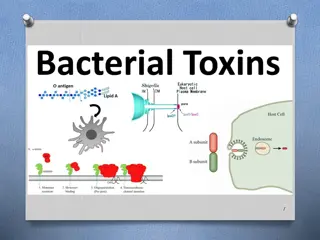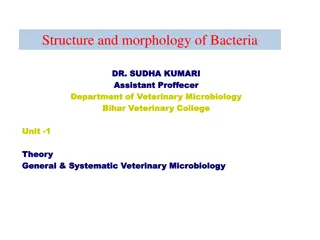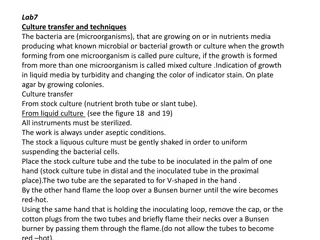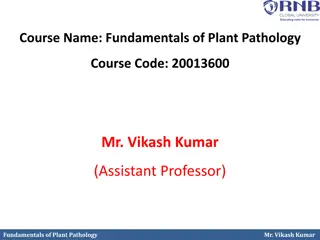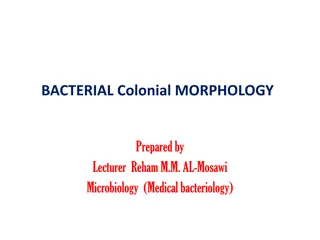Bacterial Growth and Morphology Overview
In this insightful presentation by Noor Ali Jabbar, delve into the world of bacterial growth and morphology. Learn about microbial growth phases, generation times, nutrient requirements, and more essential facets of bacterial biology.
Download Presentation

Please find below an Image/Link to download the presentation.
The content on the website is provided AS IS for your information and personal use only. It may not be sold, licensed, or shared on other websites without obtaining consent from the author.If you encounter any issues during the download, it is possible that the publisher has removed the file from their server.
You are allowed to download the files provided on this website for personal or commercial use, subject to the condition that they are used lawfully. All files are the property of their respective owners.
The content on the website is provided AS IS for your information and personal use only. It may not be sold, licensed, or shared on other websites without obtaining consent from the author.
E N D
Presentation Transcript
Lap. Lap.5 5+ +6 6 Bacterial Growth and bacterial morphology By: Noor Ali Jabbar
Microbial growth: Microbes grow via binary fission, resulting in exponential increases in numbers Bacterial growth means an increase in the number of cells, not an increase in cell size. One cell becomes colony of millions of cells .
Generation Time Average for bacteria is 1-3 hours Escherichia coli Escherichia coli: 20 minutes,1 cell becomes 1 million cells. Generation time; is the time it takes for a single cell to grow and divide Mycobacterium Mycobacterium much slower: (12-24h) r bacteria is 1-3 hours Escherichia coli: 20 minutes 20 generations (7 hours), 1 cell becomes 1 million cells! Mycobacterium much slower: (12-24h) s for a single cell to grow and divide Average for bacteria is 1-3 hours
Phases of Growth Four main growth phases -Lag phase -Log phase -Stationary phase (Post-exponential) -Decline phase
Requirements for Growth Bacteria must obtain or synthesize Amino acids, Carbohydrates & Lipids Requirement of growth included: 1.Nutrients 2.Temperature 3.Oxygen 4.pH (potential of hydrogen) 5. Osmotic pressure
1. Nutrient -Carbon sources -Nitrogen sources -Inorganic salts and trace elements -Growth factors -Water
Nutritional types of bacteria A. Depend on how the organism obtains carbon for synthesizing cell mass divided into: autotrophic carbon is obtained from carbon dioxide (CO2) heterotrophic carbon is obtained from organic compounds mix trophic carbon is obtained from both organic compounds and CO2
B. Depend on how the organism obtains energy for living and growing: chemotrophic energy is obtained from chemical compounds phototrophic energy is obtained from light
2 2. .Temperature Temperature *Psychrophiles: cold-loving, can grow at 0 C. *Mesophiles: moderate temperature-loving . *Thermophiles: heat-loving
3.Oxygen (a) Obligate aerobes require O2 (b) Obligate anaerobes die in the presence of O2 (c) Facultative anaerobes can use O2 but also grow without it (d) Aerotolerant anaerobe -requires lower oxygen to survive. (e) Microaerophilic : tolerate the presence of oxygen but does not require it for its growth
4. pH Organisms can be classified as: Acidophiles: Acid loving . - Grow at very low pH (0.1 to 5.4) Neutrophiles: PH (7 ) Includes most human pathogens Alkalophiles- Grow at pH 5.4 to 8.5.
5. Osmotic Pressure Microbes require minerals or nutrients for their growth, which can be obtained from the surrounding water
Bacterial morphology Bacterial morphology Shape: There are three basic morphologies of bacteria (based on the shape of a single cell) : bacilli (little rod): rod-shaped bacterium, such as Escherichia coli cocci (grain or berry) : such as Staphylococcus spirillum (coiled or helical).Actinomyces species
Arrangement: A.Some coccus bacteria form aggregates such as 1. cluster: the grapelike clusters ex: Staphylococcus aureus . 2. chains: like Streptococcus spp. 3. diplococcus (two cells together) observed in Streptococcus pneumonae or Neisseria species. 4. tetrad: micrococcus spp.
B.Bacillus bacteria arrenge like: B.single: coccobacillus or bacillus C.pairs: diplobacilli D.chains: Bacillus anthracis C.Spiral bacteria: three groups of spirals : 1. vibrios: single curve (comma shaped) ex: Vibrio spp.. 2. spirillum: rigid two or more curves, cork screw shape 3. spirochetes: flexible two or more curves, wavy .
Size of bacteria: Unit for measurement : Micron or micrometer, m: 1 m=10-3mm Size: Varies with kinds of bacteria, and also related to their age and external environment. Cocci: sphere, 1 m Bacilli: rods , 0.5-1 m in width -3 m in length Spiral bacteria: 1~3 m in length and 0.3-0.6 m in width


